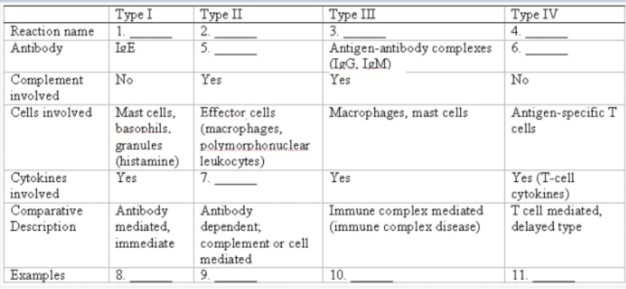Short Answer
Fill in the blanks in the table.
Classification of Hypersensitivity Reactions
Options for 1-4:
A)Anaphylactic
B)T cell-dependent
C)Cytotoxic
D)Immune complex
Options for 5 and 6:
A)IgM
B)IgG
C)IgE
D)None
Options for 7:
A)Yes
B)No
Options for 8-11:
A)Anaphylaxis,hay fever,asthma,food allergy
B)Thrombocytopenia,transfusion reactions,hemolytic disease of newborn
C)Allergy or infection,contact dermatitis
D)Arthus reaction,serum sickness
Correct Answer:

Verified
1,A;2,C;3,D;4,B;5,B;...View Answer
Unlock this answer now
Get Access to more Verified Answers free of charge
Correct Answer:
Verified
View Answer
Unlock this answer now
Get Access to more Verified Answers free of charge
Q2: The Arthus reaction is associated with the
Q3: <img src="https://d2lvgg3v3hfg70.cloudfront.net/TB8507/.jpg" alt=" -Asthma is an
Q4: <br>Match the terms with the appropriate description.<br>-Immediate
Q6: <br>Match the terms with the appropriate description.<br>-Anaphylactoid
Q7: Table 26-1<br>Classification of Hypersensitivity Reactions<br><img src="https://d2lvgg3v3hfg70.cloudfront.net/TB6126/.jpg" alt="Table
Q8: Histamine can<br>A)lead to constriction of bronchial smooth
Q8: Type I hypersensitivity reactions are characterized by:<br>A)
Q12: Cell-mediated immunity is responsible for<br>A)contact sensitivity.<br>B)elimination of
Q13: Anaphylaxis is characterized by all the following
Q15: Immune complex reactions can:<br>A) suppress or augment